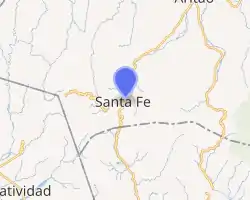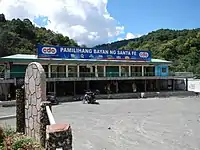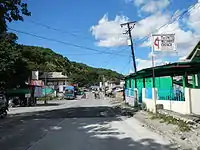Santa Fe, Nueva Vizcaya
Santa Fe, officially the Municipality of Santa Fe (Gaddang: Ili na Santa Fe; Ilocano: Ili ti Santa Fe; Tagalog: Bayan ng Santa Fe), is a 3rd class municipality in the province of Nueva Vizcaya, Philippines. According to the 2015 census, it has a population of 16,180 people. [3]
Santa Fe | |
|---|---|
| Municipality of Santa Fe | |
.jpg.webp) | |
 Seal | |
 Map of Nueva Vizcaya with Santa Fe highlighted | |
OpenStreetMap 
| |
.svg.png.webp) Santa Fe Location within the Philippines | |
| Coordinates: 16°09′43″N 120°56′20″E | |
| Country | |
| Region | Cagayan Valley (Region II) |
| Province | Nueva Vizcaya |
| District | Lone district |
| Barangays | 16 (see Barangays) |
| Government | |
| • Type | Sangguniang Bayan |
| • Mayor | Tidong A. Benito |
| • Vice Mayor | Jonathan M. Tindaan |
| • Representative | Luisa L. Cuaresma |
| • Electorate | 11,635 voters (2019) |
| Area | |
| • Total | 399.81 km2 (154.37 sq mi) |
| Elevation | 913 m (2,995 ft) |
| Population | |
| • Total | 16,180 |
| • Density | 40/km2 (100/sq mi) |
| • Households | 3,721 |
| Economy | |
| • Income class | 3rd municipal income class |
| • Poverty incidence | 15.14% (2015)[4] |
| • Revenue | ₱96,284,067.56 (2016) |
| Time zone | UTC+8 (PST) |
| ZIP code | 3705 |
| PSGC | |
| IDD : area code | +63 (0)78 |
| Climate type | tropical rainforest climate |
| Native languages | Gaddang Ilocano Ibaloi Kallahan language Tagalog |
It is the only town that borders Pangasinan and is a typical bus stop for commuters going to the provinces of Isabela and Cagayan. This town is the end point of the Dalton Pass, a zig zag road from San Jose to Carranglan, Nueva Ecija. Local products include brooms, strawberry jam, strawberry wine, peanut butter, orchids and quilts.
History
The Municipal district of Imugan (now Santa Fe) was an Igorot settlement during the Spanish era. It was one of the settlements discovered during the mission of Ituy, which later became part if the jurisdiction of the Commandencia of Kayapa. It became part of Aritao before it finally stood independently as a small rich town.
Its original inhabitants were the Kalanguya, cultural minority belonging to the Igorot tribe then later on followed by the Pangasinenses and the Tagalogs. Owing to the industriousness and the perseverance of the immigrants, the places gradually turn to be the progressive and the productive municipal district. With the advancement of time the immigrants themselves derived the same Santa Fe in honor of the Patron Saint San Jose-Santa Fe.
The Municipal district of Imugan was founded by Governor General Francis Burton Harrison in 1917. On 9 November 1950, Executive Order No. 368,[5] signed by President Elpidio Quirino, abolished the municipal district structure in government and attached Imugan to Aritao and Kayapa. Republic Act. No. 2179 [6] was enacted on May 6, 1959 recreating the Municipal district of Imugan and changing its name to Santa Fe. By virtue of Executive Order No., 77 dated July 1, 1964[7] it was converted from a municipal district to a regular municipality by President Ferdinand E. Marcos, after learning of the town’s annual average income of P58,510.40 during the four (4) consecutive fiscal years which ended on June 30, 1964 by virtue of Republic Act No. 1515.
Barangays
Santa Fe is politically subdivided into 16 barangays.
- Bacneng
- Baliling
- Bantinan
- Baracbac
- Buyasyas
- Imugan
- Poblacion
- Sinapaoan
- Tactac
- Villa Flores
- Atbu
- Balete
- Canabuan
- Malico
- Santa Rosa
- Unib
Demographics
| Year | Pop. | ±% p.a. |
|---|---|---|
| 1918 | 3,571 | — |
| 1939 | 2,043 | −2.62% |
| 1948 | 2,126 | +0.44% |
| 1960 | 4,982 | +7.35% |
| 1970 | 4,254 | −1.57% |
| 1975 | 5,961 | +7.00% |
| 1980 | 6,338 | +1.23% |
| 1990 | 9,960 | +4.62% |
| 1995 | 11,854 | +3.32% |
| 2000 | 12,949 | +1.91% |
| 2007 | 13,421 | +0.50% |
| 2010 | 14,427 | +2.67% |
| 2015 | 16,180 | +2.21% |
| Source: Philippine Statistics Authority [3] [8] [9][10] | ||
Gallery
 Municipal hall
Municipal hall Public market
Public market.jpg.webp) Balete Pass National Park
Balete Pass National Park Municipal hall complex
Municipal hall complex Town proper
Town proper
References
- Municipality of Santa Fe | (DILG)
- "Province: Nueva Vizcaya". PSGC Interactive. Quezon City, Philippines: Philippine Statistics Authority. Retrieved 12 November 2016.
- Census of Population (2015). "Region II (Cagayan Valley)". Total Population by Province, City, Municipality and Barangay. PSA. Retrieved 20 June 2016.
- "PSA releases the 2015 Municipal and City Level Poverty Estimates". Quezon City, Philippines. Retrieved 1 January 2020.
- "Reorganizing the municipalities and municipal districts in the province of Nueva Vizcaya into ten municipalities, defining their boundaries, and abolishing the municipal districts". Official Gazette of the Republic of the Philippines. Retrieved 2021-01-12.
- "An Act to Recreate the Municipal District of Imugan, Province of Nueva Vizcaya, Which Name is to be Changed to Santa Fe". LawPhil.net. Retrieved 2021-01-12.
- "CLASSIFYING MUNICIPAL DISTRICTS IN THE PHILIPPINES AND DECLARING CERTAIN MUNICIPAL DISTRICTS AS MUNICIPALITIES AND CERTAIN MUNICIPALITIES AS FIRST CLASS MUNICIPAL DISTRICTS". Official Gazette of the Republic of the Philippines. Retrieved 2021-01-12.
- Census of Population and Housing (2010). "Region II (Cagayan Valley)". Total Population by Province, City, Municipality and Barangay. NSO. Retrieved 29 June 2016.
- Censuses of Population (1903–2007). "Region II (Cagayan Valley)". Table 1. Population Enumerated in Various Censuses by Province/Highly Urbanized City: 1903 to 2007. NSO.
- "Province of Nueva Vizcaya". Municipality Population Data. Local Water Utilities Administration Research Division. Retrieved 17 December 2016.
External links
| Wikimedia Commons has media related to Santa Fe, Nueva Vizcaya. |